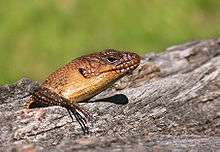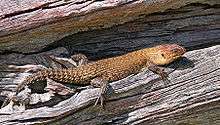Cunningham's skink
| Cunningham's skink | |
|---|---|
 | |
| Skink basking in the sunlight | |
| Scientific classification | |
| Kingdom: | Animalia |
| Phylum: | Chordata |
| Class: | Reptilia |
| Order: | Squamata |
| Family: | Scincidae |
| Genus: | Egernia |
| Species: | E. cunninghami |
| Binomial name | |
| Egernia cunninghami (Gray, 1832) | |
| Synonyms | |
|
Tiliqua cunninghami Gray, 1832 | |
Cunningham's skink (Egernia cunninghami) is a large skink species native to southeastern Australia. It can reach up to 400 mm in length, and may be confused with blue-tongued lizards.
They have a distinctive keel on each scale, which gives them a slightly spiny appearance. Extremely variable in colour ranging from dark brown to black, with or without blotchy patches, speckles or narrow bands.[1]
It prefers to live communally in the crevices of rocky outcrops or hollow logs.[1] It is a diurnal omnivore with its diet including insects, flowers, berries, fungi, leaves and young shoots. There is currently research being done on the isolated population that inhabits the southern Mount Lofty Ranges in South Australia. This population is considered vulnerable due to the fragmented (disjunct) distribution of the 'colonies'. There is evidence that at least one of these colonies has totally disappeared. It is more common within suitable habitat along the southeastern coast and ranges of Australia.
Like some other reptiles the species it is viviparous, giving birth to six or more live young in a litter.
Inbreeding avoidance
Habitat fragmentation can affect a species population by disrupting core processes. One such process is inbreeding avoidance (avoiding inbreeding depression). The impact of habitat alteration (deforestation) on inbreeding was studied in the rock-dwelling Australian lizard Egernia cunninghami.[2] Such populations in deforested areas experience potentially inbreeding-enhancing factors such as reduced dispersal and increased relatedness. However, active avoidance of close kin as mates was observed, as indicated by the substantially lower relatedness in actual breeding pairs compared to potential ones expected if there were random mating. This finding, as well as heterozygous excesses in immature lizards from disturbed (as well as undisturbed) habitats indicted that E. cunninghami maintains outbreeding in the face of increased accumulation of relatives.
Gallery
 Basking on fallen log
Basking on fallen log Two skinks resting on granite boulders, the spiny keel of the scales can be seen on the tail
Two skinks resting on granite boulders, the spiny keel of the scales can be seen on the tail Cunningham's skink in southern ACT
Cunningham's skink in southern ACT Three skinks, Cabbage Bay, near Sydney, NSW
Three skinks, Cabbage Bay, near Sydney, NSW
References
| Wikimedia Commons has media related to Egernia cunninghami. |
| Wikispecies has information related to: Egernia cunninghami |
- 1 2 Wilson S, Swan G. A Complete Guide to Reptiles of Australia. Second edition. Sydney:New Holland Publ., 2003
- ↑ Stow AJ, Sunnucks P (2004). "Inbreeding avoidance in cunningham's skinks (Egernia cunninghami) in natural and fragmented habitat". Mol. Ecol. 13 (2): 443–7. doi:10.1046/j.1365-294x.2003.02060.x. PMID 14717898.
- Egernia cunninghami, Australian Faunal Directory
- Cunningham's skink fact sheet, Museum of Victoria